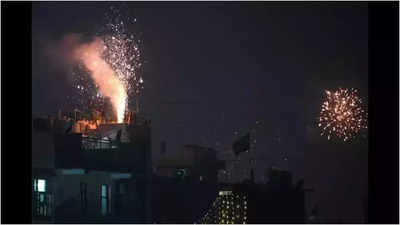- News
- India News
- Weather rescues Delhi's air: 2nd cleanest post-Diwali since 2015
Trending
Weather rescues Delhi's air: 2nd cleanest post-Diwali since 2015
Delhi's air quality plummets to 'very poor' levels post-Diwali due to increased firecracker usage, stubble burning, and local emissions. Favorable weather conditions, including high wind speeds and above-normal temperatures, prevent it from reaching 'severe' levels. Authorities warn of worsening pollution in the coming days due to rising stubble burning incidents.

Representative Image
High ventilation by winds of up to 16km/h and above-normal temperatures kept AQI within the “very poor” range, making it the second cleanest post-Diwali day since 2015.

With clear skies, the day after Diwali was good in comparison to years like 2020 and 2021 — when air quality had plummeted to severe — and even last year, when AQI was 358. However, despite favourable conditions and lack of winter chill, post-Diwali 2024 still managed to spill a toxic cocktail of pollutants into the air.
AQI peaked at 362 at 9am on Friday morning as the pollution load kept increasing until that time. However, after that, it gradually improved. By noon, it had improved to 354 on Friday, while the day’s average AQI was 339 against 328 on Thursday.

"Even though the air quality on Diwali was in the very poor category — hitting severe levels during midnight — these conditions dissipated quickly the next day to reach moderate levels by the afternoon. This is mainly because of relatively warm conditions with reasonable wind speed and natural ventilation. The deep calm winter inversion conditions are yet to set in. Despite this, the month of October has also seen more poor and very poor days than previous years, even when the contribution of farm fires has been just around 1-3%, indicating a very high impact of local and regional pollution,” said Anumita Roychowdhury, executive director, Research and Advocacy at the Centre for Science and Environment (CSE).
Friday morning also turned hazy, which cleared with the winds and sun. According to the weather department, the wind speed was between 12- 16km/h until midnight on Diwali, which dropped to 3-7 km/h towards midnight but increased again on Friday morning, helping with ventilation and dispersal of pollutants.
However, even as post-Diwali AQI 2024 turns out to be the second cleanest since 2015, what's concerning is the hourly spike in PM2.5 levels in some areas, which, as per the DPCC, spiked to more than 30 times the national permissible limits. "In addition to pollution from firecracker bursts, stubble burning incidents in Punjab are on the rise, signalling that post-harvest burning is ramping up and will likely exacerbate pollution in DelhiNCR over the next two weeks. Immediate intervention from authorities is crucial to manage this issue," stated Sunil Dahiya, founder and lead analyst, Envirocatalysts.
According to Abhishek Kar, senior programme lead, Council on Energy, Environment and Water (CEEW), while the wind speeds reaching over 2m/s between 7am and 4pm on Friday helped the city, the air quality is yet to see a breather. "The air quality will remain an issue in the coming days due to an increase in stubble burning in the upwind states of Punjab and Haryana. According to the AQEWS, the AQI for the next seven days is expected to be consistently above 350 and will occasionally breach the 400- mark,” said Kar.
End of Article
FOLLOW US ON SOCIAL MEDIA
Visual Stories
Hot Picks
TOP TRENDING
Explore Every Corner
Across The Globe










